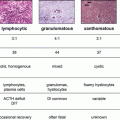Time
CHOL
HDL
Tri-glyceride
Non-HDLc
ApoB
Non-HDLc/apoB
TSH
Weight
Treatments
Baseline
352
35
478
317
–
5.8
135
Baseline
2 weeks
340
34
452
306
87
3.5
5.6
–
None
3 months
220
39
267
181
62
2.9
0.82
128
Diet, ↑ l-thyroxine
5 months
114
40
192
74
32
2.3
–
126
Atorvastatin 20 mg/day
She underwent lower extremity arterial plethysmography and was found to have moderately reduced perfusion of the left lower extremity at the infrapopliteal artery level. Pharmacologic stress myocardial perfusion study gave normal results.
Her left calf claudication was treated with an exercise program and lipid management with diet and atorvastatin. Claudication resolved 6–9 months after initiation of these therapies.
How the Diagnosis Was Made
The diagnosis of type-III hyperlipoproteinemia was suggested by the elevation of cholesterol and triglyceride levels and also by yellowish discoloration of her palmar creases. It was further suggested by an elevation of the ratio of non-HDL cholesterol to apolipoprotein B; values above 2.5 indicating likelihood of type-III hyperlipoproteinemia. The diagnosis was confirmed by apoE genotyping which showed homozygosity for the ε2 allele of apoE.
The genetic defect allowing expression of type III hyperlipoproteinemia is mutation of the gene for apolipoprotein E [1]. ApoE is the receptor recognition site on partially catabolized remnants of VLDL and chylomicrons responsible for their clearance by LDL receptors or by the high capacity low affinity heparan sulfate proteoglycans receptors involved in clearance of these remnants from the plasma. The mutant apoE protein of type III hyperlipoproteinemia, termed apoE2, is poorly bound by the LDL receptor and by the heparan sulfate proteoglycans receptors for remnants of triglyceride-rich lipoproteins. The commonest mutation causing the apoE2 isoform of apoE is arg158→cys; this results from the ε2 allele of the APOE gene. This amino acid substitution in the apoE protein results in impaired clearance of these remnant lipoproteins and their accumulation in plasma causing elevation of plasma levels of both cholesterol and triglyceride. The ε2 allele of the gene for apoE is by far the commonest mutation of APOE that causes type-III hyperlipoproteinemia, homozygosity for this allele being present in >90 % of patients with type-III hyperlipoproteinemia. Homozygosity for ε2 occurs in about 1 % of the population. However, fewer than 5 % of patients homozygous for the ε2 allele develop type-III hyperlipoproteinemia. An additional metabolic insult causing either increased synthesis of very low density lipoprotein (VLDL) or decreased clearance is necessary for hyperlipidemia to manifest itself. These additional metabolic insults include increased age, overweight, and insulin resistance, polymorphisms of lipolysis genes, hypothyroidism, menopause, certain medications (e.g., atypical antipsychotics such as olanzapine). Pregnancy has been reported to produce such severe hypertriglyceridemia in an ε2 homozygous woman as to cause pancreatitis [2].
Laboratory diagnostic criteria for type-III hyperlipoproteinemia have evolved considerably since the early 1950s when the plasma from these patients was noted to demonstrate a characteristic lipoprotein pattern on analytical ultracentrifugation. In the 1960s, the presence of an unusually broad band of lipoproteins with beta electrophoretic mobility was noted to be associated with this condition as was the presence of VLDL with beta electrophoretic mobility (normal VLDL has prebeta mobility). Beginning in the early 1970s, abnormalities of lipoprotein composition reflecting remnant accumulation were utilized in diagnosis. In particular, a landmark 1975 analysis of the clinical, genetic, and biochemical characteristics of 49 patients with type-III hyperlipoproteinemia gave a diagnostic criterion of cholesterol/triglyceride ratio of VLDL >0.30 type-III hyperlipoproteinemia [3]. Since VLDL remnants are relatively cholesterol rich, this criterion may be taken as an indicator of the accumulation of these remnants. A disadvantage of this criterion is that it requires isolation of VLDL by preparative ultracentrifugation. More recently, it has been suggested that a ratio of non-HDLc/apolipoprotein B (both in mg/dl) >2.5 be used as a screening criterion for type-III hyperlipoproteinemia [4]. This ratio also is based on the cholesterol-rich nature of the remnants of VLDL and chylomicrons that accumulate in this disease.
The current gold standard diagnostic criterion for type-III hyperlipoproteinemia is based on our understanding of the role of apoE genetics in the pathophysiology of type III hyperlipoproteinemia. Type-III HLP can be diagnosed when mixed hyperlipidemia occurs in the presence of homozygosity for the ε2 allele of APOE. However, approximately 10 % of patients with type-III hyperlipoproteinemia are not homozygous for the ε2 allele of APOE; they have other far less common mutations of APOE and require more detailed genetic analysis for diagnosis. Many of these individuals with rare mutations of the APOE gene will manifest type-III hyperlipoproteinemia with only a single allele of the mutant gene; they may also develop hyperlipidemia in childhood, a very rare occurrence for typical type-III hyperlipoproteinemia [1, 3].
It is suggested that initial screening of patients with mixed hyperlipidemia for non-HDLc/apolipoprotein B ratio >2.5 be used to identify individuals who warrant apoE genotyping. This was done in the current case.
In this patient, clinical characteristics also suggested that a diagnosis of type-III hyperlipoproteinemia be entertained.
She was noted to have yellowish discoloration of her palmar creases. This is a mild form of palmar xanthomas (also called palmar planar xanthomas or xanthoma striata palmaris). In more pronounced form, these lesions also cause some nodularity within the palmar creases. Palmar xanthomas appear to be specific for type-III hyperlipoproteinemia and have been reported to occur in approximately 50–70 % of patients. However, other types of xanthomas can also be seen including tendon xanthomas and tuboeruptive xanthomas [3].
Stay updated, free articles. Join our Telegram channel

Full access? Get Clinical Tree




